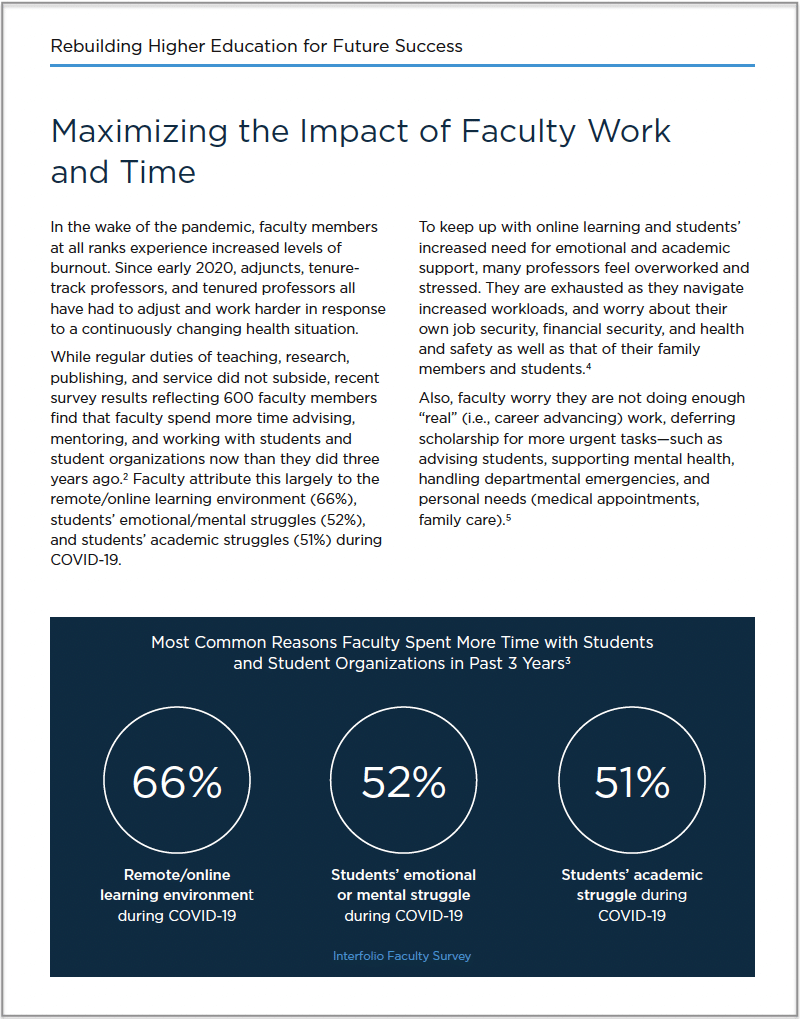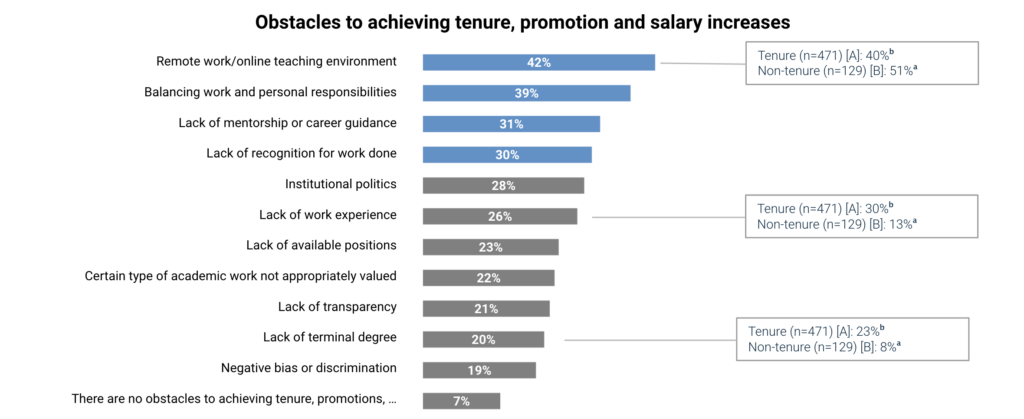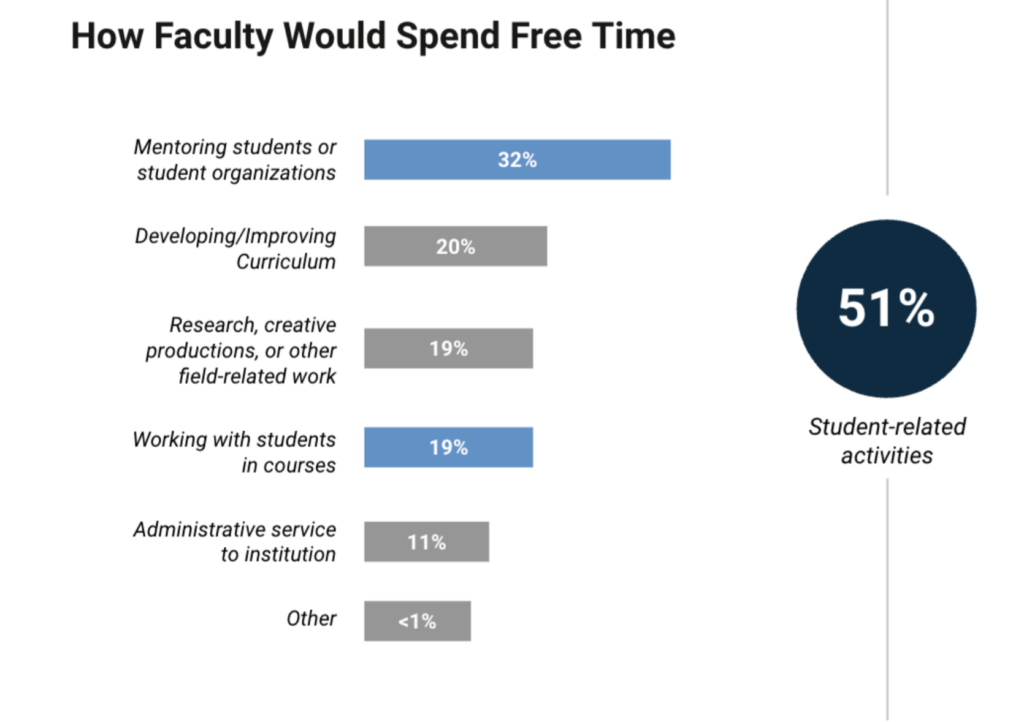A recent survey conducted by Interfolio and Hanover Research of over 600 faculty members from higher education institutions across the country provides a revealing snapshot of faculty’s feelings regarding their workloads, career journeys, and faculty technology. As part of a three-part series looking at the survey results, this blog article details survey insights into faculty career journeys.
One-third of your faculty feel underappreciated, and 93% of them perceive troubling obstacles to tenure and promotion, according to a recent survey Interfolio conducted of over 600 faculty members ranging from adjuncts to full-time professors.
Reacting to these results, faculty affairs professionals Interfolio interviewed expressed that higher education must act to improve faculty work-life balance.
How exactly colleges and universities should change faculty career journeys remains unclear, but one thing is certain:
If institutions want to stop the Great Resignation of faculty that has begun, they must embrace the Great Reset and, like other businesses, fundamentally rethink faculty careers.
Faculty Survey Identifies Key Tenure and Promotion Obstacles
Only seven percent of faculty we surveyed feel there are no obstacles to achieving tenure and promotion.
When asked to identify up to five obstacles to achieving tenure, promotions, and/or salary increases, the most common obstacle respondents chose was remote work and online teaching, with balancing work and personal responsibilities not far behind.
Roughly one-third of respondents also feel lack of mentorship or career guidance is one of their greatest obstacles. You can see the full list of identified obstacles below:
Considered together, these survey results suggest faculty perceive many significant obstacles to advancement in their careers.
Our survey also asked those faculty that feel underappreciated to identify the specific impact they’re making that they feel may go underappreciated in career advancement conversations.
The top two impacts that may go underappreciated, both of which were selected by 54% of the respondents, were diversity, equity, and inclusion work and creative productions. 45% of faculty chose student mentorship as an impact that may go underappreciated.
Another sobering finding from the survey was that only 37% of the respondents agree that their institution is good at retaining underrepresented faculty.
Faculty Affairs Administrators Recognize Need for Change
In response to these survey results, several faculty affairs administrators we spoke to elaborated on how their institutions are working to address obstacles to faculty promotion and tenure.
At New York University (NYU), faculty were able to include a COVID impact statement in their reviews for promotion, and NYU also granted all tenure-track faculty a one-year tenure COVID-related clock extension, unless the faculty member requested to stay on the original tenure clock.
NYU faculty are also asking for additional guidance and transparency on the “trajectory to get to tenure,” says Charlton Mcllwain, Vice Provost for Faculty Engagement and Development at NYU.
The exact trajectory to obtain tenure isn’t the only thing that is unclear on campuses. Other institutions are wondering how to improve faculty work-life balance.
“The pandemic brought to life the fact that our work-life balance was untenable to start with,” observes Laura Robbins, Associate Dean, Office of Faculty Information, at John Hopkins University School of Medicine. “And now what people are craving is something that should have been available the whole time: a better work-life balance. So, as a country and as an institution, we have to ask: ‘Are we going to change the way we do business and our measure of success?’”
NYU is also wondering how to enable better work-life balance for its scholars, Mcllwain says:
“When I go to our early-career faculty and say, ‘It’s imperative for you to find work-life balance,’ it’s great for me to say that, but the ultimate response is, ‘Okay, well, what are you going to do to help me make sure I can actually make that a reality?’ And I think that’s going to be a challenge for us moving forward.”
NYU is also exploring how it can give greater weight in the tenure and promotion review process to teaching and activities relating to diversity, equity, and inclusion.
Likewise, at JHUSOM, “there is a conversation taking place among the departments and within the administration about needing to rethink and reweigh review criteria,” says Robbins.
As part of efforts to modify their tenure and promotion reviews, these institutions are also taking steps to capture the full diversity of faculty activities, so that these activities can be recognized and rewarded during the review process.
“It’s critical to have a structure that captures what faculty are doing so that institutions can recognize faculty’s contributions. That’s one of the reasons we adopted the Interfolio Faculty Activity Reporting module — to help us meet that challenge,” says Mcllwain.
In addition to better capturing faculty activities, institutions need to fundamentally change their review and promotion practices and policies, argues Rob Nelson, Executive Director for Academic Technology & Planning at the University of Pennsylvania.
“It’s easier in some ways to launch a new initiative to recognize faculty than it is to change the structures that have been in place for a while, but we have to do the hard work of updating our tenure and promotion review practices and requirements to better reflect new institutional priorities,” says Nelson.
If you’d like to learn more about how institutions are pursuing these reforms, we recommend the white paper The Time is Now: Rebuilding Higher Education: How Faculty Affairs Professionals Can Lead their Institutions to Future Success.






